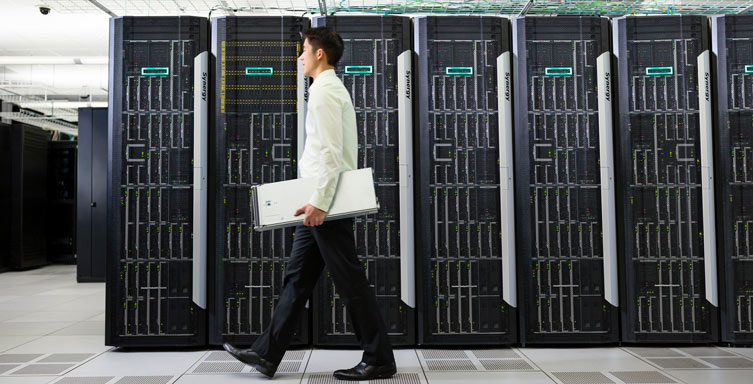Powered by Intel®, Synergy is Hewlett Packard Enterprise’s (HPE) hardware foundation for its “composable” vision. Composable uses software-defined intelligence to tell the infrastructure how to compose a combination of compute, storage and network fabric to meet the needs of an application or workload. Unlike hyperconverged solutions, Synergy can run workloads on physical servers, as well as virtual servers and containers.
Introduction
HPE has coined a name for a new business paradigm – the Idea Economy. This describes the need for businesses to become far more agile, much more focused on business growth, and instantly responsive to customer needs and competitive threats. It demands an environment where ideas can be quickly converted into applications and deployed very rapidly. Supporting the Idea Economy requires reinventing the IT which evolved around legacy stacks of independent technology.
Composable Infrastructure
Composable infrastructure is a framework whose physical compute, storage, and network fabric resources are treated as services. When a software applications requests infrastructure to run, the available resources required to run the application are located through an automated discovery process, and these resources are aggregated and allocated on demand. The infrastructure required by an application can leverage pre-defined templates which aggregate a combination of physical resources and allocate those resources to the application.
The goal of composable infrastructure is to allow the business to use its own physical infrastructure in a more cost-effective manner by reducing waste, and, more importantly, the amount of time it takes to deploy a new application. Note that composable enables an internal IT organisation to provision workloads just as quickly and efficiently as public cloud providers can, while maintaining control over the infrastructure that supports mission-critical applications in what is essentially a private cloud setting.
Benefits of HPE Synergy
- Efficient use of physical resources.
- The HPE Synergy Composer leverages repeatable templates that configure resources via software-defined intelligence that create a configuration automatically without human intervention. This boosts resource-efficiency and human productivity.
- Enhanced scalability
- With HPE Synergy, you can instantly compose and recompose fluid pools of physical and virtual compute, storage and fabric resources into any configuration to run any application or workload.
- Speed of execution
- Composable reduces the time spent on provisioning and reprovisioning infrastructure, freeing up resources for other tasks. HPE Synergy’s software-defined intelligence API allows you to instantly configure your system to meet application needs.
- Error reduction
- HPE’s OpenView Global Dashboard provides unified management, consolidating alerts, search, sign-on and launch mechanisms for resources spanning data centres across sites. This simplicity greatly reduces the opportunity for errors to be made.
- Cloud-like features without a public cloud service
- Access the speed and scalability of cloud, along with the enhanced ability to collaborate and streamline your workflow.
Synergy Use Cases
Synergy was developed to be able to run existing traditional-type workloads, as well as the emerging new applications being created as part of the Idea Economy, and the “third platform” pillars of mobile, big data/analytics, cloud and social technologies. The adoptions of agile and DevOps have created an expectation of being able to iterate very rapidly through development and test and production.
- HPE Synergy is well optimised for the traditional VMware and Microsoft applications.
- When it comes to the newer applications, with rapid test and development iteration, and a transition to production as quickly as possible, Synergy really shines. Synergy can provide the exact same system for test, as it can for production, so bandwidth and performance testing of CPU, storage and networks can be easily adapted into production.
- Composable cuts down configuration and reconfiguration time in test mode, leading to a shortened test cycle time.
- For production workloads, an organisation will have some VMware-based applications, some SQL server, some Oracle enterprise applications, perhaps Sharepoint too. Normally these would require islands of infrastructure tuned to the specific needs of the workload characteristics. Synergy offers a single infrastructure that can present multiple configurations adapted for each workload.
- Storage can similarly be presented to meet specific performance and capacity needs, including big data applications.
- Essentially, Synergy supports a very wide range of workloads.
Quantifying data centre inefficiency: Making the case for composable infrastructure
Digital transformation requires the ability to run next-generation applications alongside legacy apps, which in turn requires IT departments to manage infrastructure duality. IDC recently conducted a study on data centre infrastructure and operations efficiency among medium-sized and large enterprises, which found that nearly all data centres in enterprise IT have areas where efficiency can be improved.
- Median people efficiency in enterprise IT is 55%.
- Median process efficiency in enterprise IT is 30%.
- Median technology efficiency in enterprise IT is 50%.
For your copy of IDC’s study, please contact us here at Viatek on 1300-842-835

The Intel logo is a trademark of Intel Corporation or its subsidiaries.







